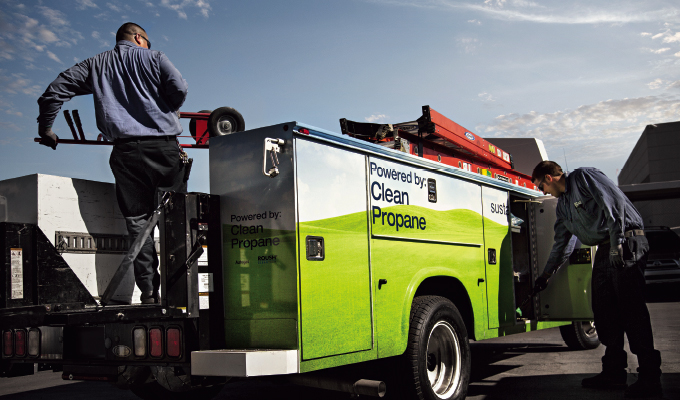With pressure from climate groups, government agencies, and corporate leadership, more industries are beating the drum of lowering emissions. Vehicle emissions are at the forefront of this charge, with more fleets turning to a variety of energy sources to meet aggressive emissions standards. But one of the biggest questions remains—how do contractors achieve these emission goals while keeping costs low and vehicle performance high? A new engine solution has come onto the scene that has the answer.
The Cummins B6.7™ Propane is a 6.7-liter displacement engine built on Cummins’ new fuel-agnostic B-series platform and powered with propane autogas. The high-performing, low-carbon engine meets day-to-day medium-duty fleet needs while exceeding emissions standards. For contractors that need to reduce emissions but remain productive through difficult job schedules, this engine solution can help get the job done.
HIGH PERFORMANCE, RELIABILITY
Cummins B6.7 Propane engine meets emissions standards without compromising on performance or range. The new engine boasts better-than-diesel performance with a projected power rating of up to 360 hp and 860 ft-lbs of torque. Fleet owners will also reap the rewards of diesel-like durability, reliability, and high uptime.
Propane autogas also provides a range of up to 400 miles and the ability to carry a heavier payload. Not every energy source can meet those needs. For instance, electric vehicles need to recharge long before a propane autogas vehicle would need to refuel.
EMISSIONS STANDARDS MET
Beyond performance, fleet owners can rest easy knowing the new engine will check the emissions standards box now and well into the future. In testing, the Cummins B6.7 Propane engine produced the lowest greenhouse gas emissions of any propane autogas-powered engine. The B6.7 will also deliver some of the lowest GHG emissions in the medium-duty market including the ultra-low .02 NOx goal that will meet or exceed EPA and CARB regulations in 2027 and beyond.
This technology becomes even cleaner when renewable propane is used in the engine. Made from a mix of waste residues and sustainably sourced materials such as agricultural waste products, cooking oil, and meat fats, renewable propane has the same chemical structure and physical properties as conventional propane, but it has an even lower carbon intensity than conventional propane. Best of all, there’s no need for special equipment to take advantage of this low-carbon option. Renewable propane is compatible with any existing propane autogas engine or propane autogas infrastructure.
A COST-EFFECTIVE SOLUTION
Bottom line matters, and fleets that choose propane autogas in engines like the Cummins B6.7 can benefit from lower costs over time. When you consider the cost of a new vehicle plus fuel, fluids, maintenance, and repairs, propane autogas has one of the lowest costs for the lifetime of the vehicle. Compare that to current diesel engines that require costly diesel exhaust systems components to meet increasingly stringent emissions standards. Clean propane autogas engines have only a three-way catalyst to meet these emissions standards.
The fuel itself is cheaper too. As oil prices fluctuate, propane autogas can beat diesel on price per gallon by as much as 50%. To enhance the affordability, propane autogas suppliers will often work with fleet owners to create a mutually beneficial fuel contract that allows fleets to lock in a set price per gallon over a period of time. It’s another layer of protection against turbulent fuel prices, which can be critical at times like these when gasoline and diesel prices are trending upward.
The cost-effectiveness of propane autogas becomes even more apparent when compared to electric vehicles. The incremental capital cost for a medium-duty propane autogas vehicle, relative to conventionally fueled vehicles is on average 15%. Comparatively, a similar medium-duty EV is more than 250%. Not to mention, the cost to purchase and install refueling equipment for a fleet of propane autogas vehicles is lower than the cost to purchase fast charger equipment for a comparable electric vehicle fleet in a comparable time frame.
CLOSING THOUGHT
Decisions contractors make today have the potential to make a big difference down the road, and as they consider fuel sources, new propane autogas engines such as the Cummins B6.7 Propane offer an attractive solution. With the right fuel and the right technology, fleets can hit long-term emissions goals without sacrificing performance and while lowering costs.
About the Author:
Steve Whaley is the director of autogas business development for the Propane Education & Research Council. He can be reached at stephen.whaley@propane.com. For more, visit propane.com. Fleet owners can visit propane.com/fleet-vehicles to learn more.
Modern Contractor Solutions, June 2022
Did you enjoy this article?
Subscribe to the FREE Digital Edition of Modern Contractor Solutions magazine.



